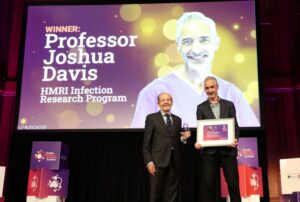
A groundbreaking development by MIT researchers has led to the creation of a 3D human brain tissue platform, known as Multicellular Integrated Brains (miBrains). This innovative model integrates all major brain cell types, including neurons, glial cells, and vasculature, into a single culture. Developed from individual donors’ induced pluripotent stem cells, miBrains replicate essential features and functions of human brain tissue. They are customizable through gene editing and can be produced in large quantities, paving the way for personalized disease research and drug discovery.
Despite their small size—each unit is smaller than a dime—miBrains hold significant potential for researchers and drug developers. These complex living lab models offer a more accurate representation of brain biology, which is crucial for understanding diseases and developing treatments. “The miBrain is the only in vitro system that contains all six major cell types present in the human brain,” stated Li-Huei Tsai, Picower Professor and director of The Picower Professor of Learning and Memory. The study detailing miBrains was published in the Proceedings of the National Academy of Sciences.
Innovations in Brain Modeling
This development follows a long-standing challenge in neuroscience: creating models that accurately reflect the brain’s complexity. Traditional models, like simple cell cultures, lack the intricate interactions necessary for understanding brain health and disease. Animal models, while complex, are costly, slow, and sometimes yield results that don’t translate to humans. miBrains bridge this gap by combining the accessibility of lab-cultured cell lines with the complexity of human brain tissue.
miBrains are derived from individual patients, making them personalized to an individual’s genome. The six cell types self-assemble into functioning units, including blood vessels and immune defenses. Notably, miBrains possess a blood-brain barrier, a critical feature for studying drug interactions.
“The miBrain is very exciting as a scientific achievement,” said Robert Langer, David H. Koch Institute Professor. “Recent trends toward minimizing the use of animal models in drug development could make systems like this one increasingly important tools for discovering and developing new human drug targets.”
Design Challenges and Solutions
Designing a model with such complexity required overcoming significant challenges. A crucial step was developing a substrate that could support the viability of various cell types. The research team drew inspiration from the extracellular matrix (ECM), which naturally surrounds cells. The miBrain’s hydrogel-based “neuromatrix” mimics the ECM, providing a scaffold for all major brain cell types and promoting the development of functional neurons.
Another critical aspect was determining the correct proportions of cell types to create functional neurovascular units. The researchers developed the six cell types from patient-donated stem cells, ensuring each type closely resembled natural brain cells. Through experimental iteration, they achieved a balance that resulted in functional neurovascular units. This modular design allows for precise control over cellular inputs and genetic backgrounds, enhancing applications in disease modeling and drug testing.
Alzheimer’s Research Breakthrough
miBrains have already demonstrated their potential in Alzheimer’s research. The team studied the gene variant APOE4, the strongest genetic predictor for Alzheimer’s disease. By integrating APOE4 astrocytes with other brain cell types, miBrains allowed researchers to mimic natural cell interactions. This setup enabled the isolation of APOE4 astrocytes’ contributions to disease pathology.
In experiments, APOE4 astrocytes in miBrains expressed immune reactivity measures associated with Alzheimer’s, highlighting the importance of a multicellular environment. The study also revealed that molecular cross-talk between astrocytes and microglia is necessary for phosphorylated tau pathology, a hallmark of Alzheimer’s.
“Given its sophistication and modularity, there are limitless future directions,” said Alice Stanton, assistant professor at Harvard Medical School. “Among them, we would like to harness it to gain new insights into disease targets and optimize drug delivery vehicles.”
The research team plans to enhance miBrains further, incorporating features like microfluidics to simulate blood flow and single-cell RNA sequencing for improved neuron profiling. These advancements could significantly impact Alzheimer’s research and beyond, offering new avenues for personalized medicine.
Funding for the study came from the BT Charitable Foundation, Freedom Together Foundation, and several other benefactors, underscoring the broad interest and potential impact of this research.




